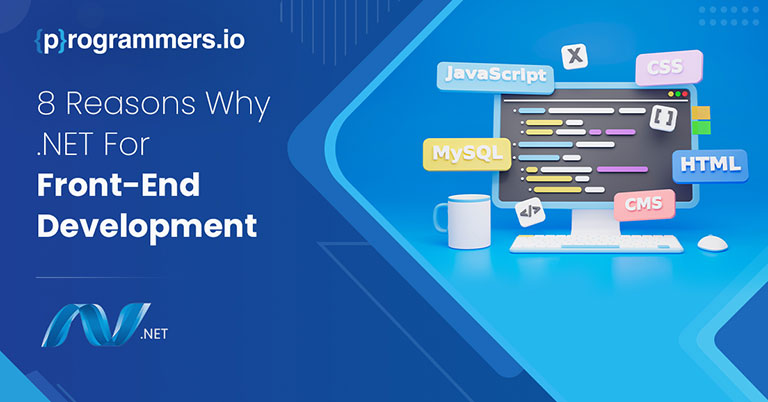8 Reasons Why .NET Should Be Your Choice Pick For Front-End Development in 2024
For front-end development, the majority of developers around the globe rely upon Javascript. This is one of the reasons why the ecosystem of frameworks around it has grown quite massive. React and Angular dominate that landscape, but there are several others. However, web development requirements are evolving and changing every day. Most developers should consider adding another framework to their front-end arsenal. That framework is .NET, and there are several reasons why it should be on a front-end developer’s radar in 2024.
.NET Front-end Development
There have been several reasons why .NET and most other languages and frameworks have fallen behind Javascript when it comes to front-end development, including but not limited to native browser support (since it’s a web standard), Client-side rendering, and a massive ecosystem of libraries, frameworks, and resources. However, with WebAssembly and dedicated front-end development frameworks like Blazor, many of these things are changing. Now, .NET front-end development has the potential to flourish, and even if the framework doesn’t dethrone Javascript as the top front-end choice, it can certainly get a much larger slice of the market than it currently has access to.
8 Benefits of Using .NET for Front-end Development
- Developer Accessibility: From a business perspective, one major benefit of using dedicated front-end frameworks like Blazor to facilitate .NET front-end development is that back-end developers with C# expertise will be able to work on the front-end as well. It can reduce the need to maintain two separate teams for web development or dip into the relatively small pool of full-stack developers, which may allow you to reduce your overhead costs significantly.
- Native Code Reusability: Even though you can technically reuse code when developing with Javascript as well, if you use it for both front-end and back-end with different frameworks, the code reusability benefit is significantly enhanced if you use .NET for front-end development. The reason is that with front-end frameworks like Blazor and C# for the back-end, the language/tech stack would be the same throughout the source code. Plus, Blazor’s strengths, like a component-based architecture and shared libraries, make code reusability easier and more comprehensive.
- Improved Performance: While it varies based on the use case, the server-side rendering that .NET offers can be quite beneficial for some web application front-ends. Since .NET front-ends also rely upon fully compiled codes, it can also improve performance in certain use cases.
- Enhanced Security Features: For many use cases, .NET front-end development can prove to be far safer, if we are comparing .NET vs. JavaScript for front-end. One reason is server-side rendering, which preemptively protects users and web applications against client-side vulnerabilities like code injection. There are also some security features that are built into the .NET framework, like Role-Based Access Control (RBAC), that you may not be able to replicate in JavaScript without increasing dependencies.
- Integrated development environment (IDE): When comparing .NET vs. Javascript for the front-end, the IDE benefit is not particularly strong, but .NET does have a clear edge, and the main reason is dedicated support features and a comprehensive ecosystem.
- Multi-Language Support: While most .NET front-end development leans heavily towards Blazor, and that’s where most of the benefits lie as well, you can leverage the power of WebAssembly to use the full range of .NET languages for front-end development. One example would be using libraries like WASM.NET.
- Growing Functionalities: Blazor framework, which can be considered the most significant force in .NET front-end development, is rapidly evolving. Server Side Rendering (SSR) has improved significantly in the new .NET version (static SSR), and features like streaming rendering have the potential to enhance page response time further.
- Integrating .NET Back-end With Front-end: One of the key strengths of using .NET for front-end development is that integrating .NET back-end with the front-end becomes increasingly easier. Blazor is the primary .NET front-end framework of choice, and for the server side, you can choose from frameworks like APS.NET Core MVC if your application requires Model View Controller (MVC) architecture or Razor Pages for self-contained pages.
There are also other noteworthy benefits as well, like Blazor’s ability to call upon JavaScript libraries and intrinsic data validation features for forms, which can enhance its front-end desirability.
.NET Front-end Development Trends
If we look into adoption rates or current user numbers when comparing .NET vs. Javascript for front-end, it’s easy to see that .NET, even with a powerful sub-framework like Blazor and standards like WebAssembly, has a lot of ground to cover. However, as Blazor (and server-side technologies like Razor) improves and incorporates more front-end-friendly features, its adoption rates are likely to grow.
But there are other .NET front-end development trends to look out for as well, like performance-oriented front-end development and growing security considerations for the front-end. Some of the strengths of .NET front-end development when it comes to specific use cases like Progressive Web Apps (PWAs), like offline capabilities and server-side rendering, may lead to its more widespread adoption when comparing .NET vs. JavaScript for the front-end.
Also, look for the best company providing .Net front-end development services. Having expert .Net developers on your .Net project is a must when it comes to quality.
.NET front-end frameworks
Blazor is the most well-known of the .NET front-end frameworks, and while there are other frameworks that can be used as (and called) .NET front-end frameworks, they may not offer the same level of dedicated front-end functionalities, strengths, and wealth of features. This includes
ASP.NET Core MVC is essentially a server-side framework but, in some cases, can be used for front-end development. Razor pages is another one that can be used as a .NET front-end framework.
Final Words
The .NET front-end development has yet to get the traction its strengths deserve, but there are several reasons why it may happen sooner than you may think and why it should be your choice for front-end development this year and going forward. This includes the need to develop larger, more complex web applications that may have to balance both server-side rendering and client-side rendering effectively. It has also proven itself to be more secure and less vulnerable due to inherent safety features that might be more difficult to replicate in the existing Javascript-based front-end ecosystem, especially as web development as a whole and front-end evolves thanks to catalysts like Artificial Intelligence (AI), Machine Learning (ML), and Internet of Things (IoT), and have different device/client side dependencies.
How can we help you?
We have hundreds of highly-qualified, experienced experts working in 70+ technologies.









